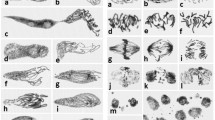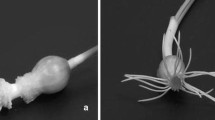Abstract
This paper is a study of the effect of exogenous DNA of different genetic origins on the repair of meristematic cells of primary roots ofVicia faba, damaged by 24 hour treatment with 0·01mm solution of Ypenyl. Both kinds of DNA,i.e. isologous and heterologous, stimulated cell proliferation which was decreased by the action of the radiomimetic and influenced both dynamics of production of chromosome aberrations and the interchromosomal distribution of induced damage. While heterologous DNA increased the frequency of aberrations after all recovery periods studied, isologous DNA significantly decreased the number of chromosomal aberrations. Heterologous DNA increased at the same time the relative number of breaks in the group of small chromosomes, while by the action of isologous DNA the number of aberrations related to this group of chromosomes was relatively decreased.
Abstract
Byl studován účinek exogenní desoxyribonukleové kyseliny různého genetického původu na reparaci meristematických buněk primárního kořeneVicia faba. Obě DNK, tj. isologní i heterologní, urychlily buněčnou proliferaci, sníženou působením radiomimetika, a ovlivnily jak dynamiku tvorby chromosomových aberací, tak interchromosomální distribuci indukovaných poruch. Zatím co heterologní DNK ve všech studovaných časových intervalech zotavení zvýšila zároveň frekvenci chromosomových aberací, isologní DNK projevila efekt reparační, takže významně procento aberací snížila. Heterologní DNK současně zvýšila počet poškození ve skupině malých chromosomů, isologní DNK naopak počet abnormalit v této skupině relativně snížila.
Abstract
Исследовалось влияние извне подапной дезоксирибонуклеиновой кислоты разного генетического происхождения на возобновительные процессы в меристематических клетках первичного корняVicia faba поврежденных 24-х часовым действием 0,01 мМол раствором Ипенила. Обе ДНК, т. е. изологная и гетерологная, ускорили процесс пролиферации клеток, замедленный под действием радиомиметического вещества и повлияли на динамику образования хромосомных аберраций а также на межхромосомальное распределение вызванных повреждений. Гетерологная ДНК во всех исследованных промежутках времени восстановления от повреждения повышала частотность хромосомных аберраций, изологная ДНК имела восстановительный эффект и значимо понижала процент аберраций. Гетерологная ДНК наряду с этим повысила количество повреждений в группе малых хромосом. Изологная ДНК напротив в данной группе количество аномалий относительно понизила.
Similar content being viewed by others
References
Borenfreund, E., Bendich, A.: A study of the penetration of mammalian cells by deoxyribonucleic acids.—J. Biophys. Biochem. Cytol.9: 81–91, 1961.
Brookes, P., Lawley, P. D.: The reaction of mono- and difunctional alkylating agents with nucleic acids.—Biochem. J.80: 496–503, 1961.
Ceriotti, G.: Determination of nucleic acids in animal tissues.—Biol. Chem.214: 59–70, 1955.
Crampton, Ch. F., Lipshitz, R., Chargaff, E.: Studies on nucleoproteins. I. Dissociation of the deoxyribonucleohistone of calf thymus.—J. biol. Chem.206: 499–510, 1954.
Crathorn, A. R., Roberts, J. J.: Mechanisms of cytotoxic action of alkylating agents in mammalian cells and evidence for the removal of alkylated groups from deoxyribonucleic acid.—Nature211: 150–153, 1966.
Djordjevič, O., Kostič, L., Kanazir, D.: Recovery of ultraviolet-irradiated L-strain cells by means of highly polymerized deoxyribonucleic acid.—Nature195: 614–615, 1962.
Fahmy, O. G., Fahmy, M. J.: Induction of mutations by deoxyribonucleic acid inDrosophila melanogaster.—Nature191: 776–779, 1961.
Farkaš, J., Šorm, F.: Nucleic acid components and their analogues. VIII. Some new derivatives of thymine.—Coll. czech. chem. Comm.26: 893–895, 1961.
Frederic, J., Corin-Frederic, J.: Modifications des chromosomes et du caryotype dans des cellules de Poulet cultivéesin vitro en présence d'acides désoxyribonucléiques de veau.—Compt. rend. Soc. Biol.156: 742–745, 1962.
Gray, L. H., Scholes, M. E.: The effect of ionizing radiations on the broad bean root.—Brit. J. Radiol.24: 348–392, 1951.
Igali, S.: The effect of deoxyribonucleic acid on the survival ofEscherichia coli populations irradiated with X-rays.—Acta biol. Acad. Sci. Hung.15: Suppl. 6, 28, 1964.
Jankovič, V., Kanazir, D.: The effect of native DNA and ionizing radiation on chromosome aberrations in bone marrow of rat.—In: Radiobiol. Symp. V. Ann. Meet. Europ. Soc. Rad. Biol., Špindlerův Mlýn, p. 87, 1967.
Kanazir, D., Becarevič, A., Panjevac, B., Simič, M., Ristič, G.: Effect of highly polymerized nucleic acids and their derivatives upon the recovery of irradiated rats.—Bull. Inst. Nucl. Sci. “Boris Kidrich” (Belgrade)9: 133–144, 1959.
Karpfel, Z., Paleček, E., Šlotová, J.: The effect of deoxyribonucleic acids on the incidence of chromosomal aberrations in irradiated and non-irradiated bone marrow.—In: Biol. effects of ioniz. rad. at molec. level, IAEA, Vienna, p. 315, 1962.
Karpfel, Z., Šlotová, J., Paleček, E.: Chromosome aberrations produced by deoxyribonucleic acids in mice.—Exp. Cell Res.32: 147–148, 1963.
Kay, E. R. M.: Incorporation of deoxyribonucleic acid by mammalian cellsin vitro.—Nature191: 387–388, 1961.
Kihlman, B. A., Hartley, B.: Hydroxyurea: Effect onVicia chromosomes previously exposed to X-rays or to radiomimetic chemicals.—Exp. Cell Res.48: 629–634, 1967.
Knight, C. A.: The nucleic acids of some strains of tobacco mosaic virus.—J. biol. Chem.197: 241–249, 1952.
Lawley, P. D., Brookes, P.: Molecular mechanism of the cytotoxie action of difunctional alkylating agents and of resistence to this action.—Nature206: 480–483, 1965.
Lowry, O. H., Rosenbrough, N. J., Farr, A. L., Randall, R. J.: Protein measurement with folin phenol reagent.—J. biol. Chem.193: 263–275, 1951.
Michaelis, A., Schoneich, J., Rieger, R.: Chromosomenaberrationen beiVicia faba und Ascitentumoren der Maus nach Einwirkung von N-Nitroso-N-Methylharnstoff.—Chromosoma (Berlin)16: 101–123, 1965.
Natarajan, A. T., Upadhya, M. D.: Localized chromosome breakage induced by ethylmethanesulfonate and hydroxylamine inVicia faba.—Chromosoma (Berlin)15: 156–169, 1964.
Ockey, C. A.: Chromatid aberrations induced by ethyleneimines.—In:H. Stubbe (herausgeb.) “Chemische Mutagenese”, E. Baur, Gedächtnisvorles., Abh. Deutsch. Akad. Wiss. Berlin, Kl. Medizin1: 47–53, 1960.
Read, J.: Radiation biology ofVicia faba in relation to the general problem.—Blackwell, Oxford, England 1959.
Revell, S. H.: The accurate estimation of chromatid breakage and its relevance to a new interpretation of chromatid aberrations induced by ionizing radiations.—Proc. roy. Soc. B150: 563–589, 1959
Rieger, R., Nicoloff, H., Michaelis, A.: Chelatbildung als Sensibilisierungsfaktor bei der chemischen Auslösung von Chromosomen-aberrationen.—Biol. Zbl.82: 393–412, 1963.
Savkovič, N., Kačaki, J., Hajdukovič, S.: Recovery effect of heterologous deoxyribonucleic acid from various organs on irradiated mice.—Nature211: 1179, 1966.
Szybalska, E. H., Szybalski, W.: Genetics of human cell lines. IV. DNA-mediated heritable transformation of biochemical trait.—Proc. Natl. Acad. Sci. U.S.48: 2026–2034, 1962.
Šlotová, J., Karpfel, Z.: Comparison of the effects of radiation and deoxyribonucleic acids on the mitosis in roots ofVicia faba.—Biol. Plant.8: 10–19, 1966.
Šlotová, J., Karpfel, Z., Hrazdira, I.: Chromosome aberrations caused by the effect of ultrasound in the meristematic cells ofVicia faba.—Biol. Plant9: 49–55, 1967.
Šlotová, J., Karpfel, Z.: The influence of exogenous DNA of different origin on the mitosis and chromosomes of irradiated meristematic cells ofVicia faba.—Biol. Plant.10: 190–198, 1968.
Šlotová, J., Karpfel, Z.: Action of Ypenyl [5-bis-(2-chlorethyl)-aminomethyluracil] on the chromosomes ofVicia faba.—Biol. Plant.11: 49–59, 1969.
Wilczok, T., Mendecki, J.: DNA repair of radiation damage. I. Therapeutic efficiency of DNA administered to rats after whole-body irradiation.—Int. J. Rad. Biol.9: 201–213, 1965.
Гершензон, С. М.: Мутагенное действие ДНК и проблема направленных мутаций.— Генетика 1: 3–15, 1966. [Gershenson, S. M.: Mutagenic action of DNA and problem of directed mutations.]
Author information
Authors and Affiliations
Additional information
Address: Královopolská 135, Brno, Czechoslovakia.
Rights and permissions
About this article
Cite this article
Šlotová, J., Karpfel, Z. Influence of exogenous DNA on Ypenyl-treated chromosomes ofVicia faba L.. Biol Plant 11, 216–225 (1969). https://doi.org/10.1007/BF02920800
Received:
Issue Date:
DOI: https://doi.org/10.1007/BF02920800




